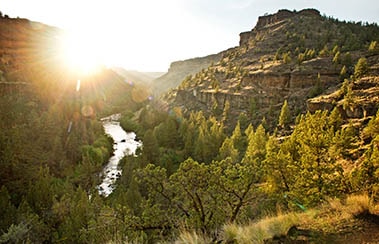This article was published on: 07/21/20 6:35 PM
Water is never more top of mind than when we have too much or too little. Here in the arid high desert of Central Oregon, it is often the case that we have too little. Climate change is threatening snowpack and this year, drought has been declared across the State. Farmers are watching significant portions of their livelihoods literally dry up. Voices are clashing over endangered species and declining river health. In the midst of all this, it’s difficult to stay hopeful.
Learning from Conflict
In the early 1990s, clashes around natural resources led to intense environmental battles and uncertainty of the path forward. To get ahead of potential conflict over water in the Deschutes Basin, representatives from the Confederated Tribes of Warm Springs, the Environmental Defense Fund, regional irrigation districts, and local legal counsel created the Deschutes River Conservancy (DRC). They saw a need for an organization that could collaborate with stakeholders and create community around solutions for the river. In 1996, the DRC was created by an act of Congress, supported by Senators Hatfield and Wyden.
Our Mission
For 25 years, the DRC has built consensus around complex solutions for challenging water issues while supporting agricultural needs. Our mission is to restore streamflow and improve water quality in the Deschutes Basin.
Building Relationships
When the DRC first started working in the Basin, there was abundant opportunity for consensus-based projects to restore flows quickly and efficiently. Without this legacy of relationship building and cooperation, our basin would not be in the place it is today.
Without Our Work
Imagine Whychus Creek turning into a dry creek bed in the summer. Imagine the Middle Deschutes (North of Bend) running at less than 5% of its natural flows during the irrigation season and, Tumalo Creek running dry. And finally, imagine magnificent Smith Rock with only a warm rivulet of water flowing past.
What Success Looks Like
Through our partnerships, we have succeeded in restoring significant flows in each of these reaches. Whychus Creek, as an example, has gone from simply drying up in late summer to becoming a revitalized year-round stream and a jewel of the community of Sisters. Today the creek provides habitat for migrating salmon and steelhead as well as opportunities for local students to interactively learn about stream ecology and art.
Innovative Tools
To restore streamflows, we have used a combination of innovative restoration tools. These tools include piping canals, transferring and leasing water rights for instream flow, and creating opportunities for sharing water resources between districts. These programs are all voluntary and done in partnership with irrigation districts and water users.
Tackling the Upper Deschutes
Restoring the Upper Deschutes and other impacted reaches is as complex as our previous endeavors, but our track record shows that long-term success is possible. We are drawing upon our history of collaboration with our partners to scale up and accelerate the restoration of the natural function of our rivers and streams. This will not be quick and easy, but we need to do the work as fast as we can. We must.
Restoring a Better Future
While we are learning to stay close to home, we are deepening our gratitude for the natural beauty surrounding us. Our vision of the future is that we are all more efficient with this precious resource. We see communities having secure water for families and businesses. And, close to all our hearts, we look forward to seeing the Deschutes River and its tributaries restored to sustainable flows for generations to come. If we work together, we can make this vision a reality.
Written by Marisa Chappell Hossick
Originally published in the Source Weekly




